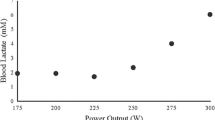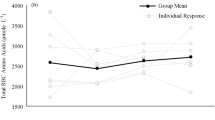Summary
The time course of venous blood ammonia and lactate formation has been investigated on 5 separate occasions in each of two subjects. Blood was sampled from a free flowing catheter for every 30 s during a ramp bicycle test to exhaustion. In each subject blood ammonia was rapidly elevated even at work rates as low as 40–50% of \(\dot VO_2\) max. On cessation of exercise blood concentrations fell rapidly. Lactate concentration in blood on the other hand was more slowly elevated during the test and continued to rise in the usual fashion after the completion of the work. It is suggested that ammonia may be a primary toxin during exhaustive exercise inducing changes, which ultimately become incapacitating, in essential metabolic functions.
Thus fast ammonia accumulation in tissue reflected by increased blood ammonia levels may induce glycolysis and an early excessive tissue pyruvate accumulation and lactate formation.
Ammonia also passes the blood brain barrier and might possibly result in the observable central nervous system symptoms of dysfunction which accompany exhaustion such as ataxia, mental confusion and syncope. These findings have important implications for the integrity of the classically accepted lactate theory of exercise fatigue.
Similar content being viewed by others
References
Allen SI, Conn HO (1960) Observations on the effect of exercise on blood ammonia concentrations in man. Yale J Biol Med 33: 133–144
Banister EW, Bhakthan NMG, Singh AK (1976) Lithium protection against oxygen toxicity in rats: ammonia and amino acid metabolism. J Physiol (Lond) 260: 587–596
Barnes RH, Labadan BA, Siyamoglu B, Bradfield RB (1964) Effects of exercise and administration of aspartic acid on blood ammonia in the rat. Am J Physiol 207: 1242–1246
Brodan V, Kuhn E, Pechar J, Placer Z, Slabochova Z (1974) Effects of sodium glutamate infusion on ammonia formation during intense physical exercise in man. Nutr Rep Internat 9: 223–232
Bryla J, Niedzwiecka A (1979) Relationship between pyruvate carboxylation and citrulline synthesis in rat liver mitochondria: the effect of ammonia and energy. Int J Biochem 10: 235–239
Cooper AJL, McDonald JM, Gelbard AS, Gledhill RF, Duffy TE (1979) The metabolic fate of 13N-labeled ammonia in rat brain. J Biol Chem 254: 4982–4992
Dutton RE, Berkman RA (1978) Ammonia and the regulation of ventilation. In: Davies DG, Barnes CD (eds) Regulation of ventilation and gas exchange. Academic Press, New York, pp 69–91
Gerez C, Kirsten R (1965) Untersuchungen über Ammoniakbildung bei der Muskelarbeit. Biochem Z 341: 534–542
Golding LA (1972) Drugs and hormones. In: Morgan WP (ed) Ergogenic aids and muscular performance. Academic Press, New York, pp 390–397
Goodman MN, Lowenstein JM (1977) The purine nucleotide cycle; studies of ammonia production by skeletal muscle in situ and in perfused preparations. J Biol Chem 252: 5054–5060
Gutmann I, Wahlefeld AW (1974) L-(+)-Lactate. In: Bergmeyer HU (ed) Methods of enzymatic analysis, 2nd edn. Academic Press, New York, pp 1464–1468
Hindfelt B (1975) The distribution of ammonia between extracellular and intracellular compartments of rat brain. Clin Sci Molec Med 48: 33–37
Hindfelt B, Siesjo BK (1970) The effect of ammonia on the energy metabolism of the rat brain. Life Sci 9: 1021–1028
Hultman E, Sahlin K (1980) Acid-base balance during exercise. In: Hutton RS, Miller DI (eds) Exercise and sport science reviews. Franklin Institute Press, Philadelphia, pp 41–128
Iles JF, Jack JJB (1980) Ammonia: Assessment of its action on postsynaptic inhibition as a cause of convulsions. Brain 103: 555–578
Katanuma N, Okada M, Nishii Y (1966) Regulation of the urea cycle and TCA cycle by ammonia. In: Wever G (ed) Advances in enzyme regulation, vol 4. Pergamon Press, New York, pp 317–335
Kun E, Kearney EB (1974) Ammonia. In: Bergmeyer HU (ed) Methods of enzymatic analysis, 2nd edn. Academic Press, New York, pp 1802–1806
Laborit H, Moynier R, Trzebski A, Guilo G, Baron C (1957) Influence de la composition ionique du milieu extra-cellulaire et influence comparé de l'acide aspartique, de l'aspartate de potassium et du glucose sur l'epreuve de nage du Rat blanc. CR Soc Biol 151: 1383–1386
Lockwood AH, McDonald JM, Reiman RE, Gelbard AS, Laughlin JS, Duffy TE, Plum F (1979) The dynamics of ammonia metabolism in man. Effects of liver disease and hyperammonaemia. J Clin Invest 63: 449–460
Lowenstein JM (1972) Ammonia production in muscle and other tissues: The purine nucleotide cycle. Physiol Rev 52: 382–414
Lowenstein JM, Tornheim K (1971) Ammonia production in muscle; the purine nucleotide cycle. Science 171: 387–400
McKann GM, Tower DB (1961) Ammonia toxicity and cerebral oxidative metabolism. Am J Physiol 200: 420–424
Meyer RA, Terjung RL (1979) Differences in ammonia and adenylate metabolism in contracting fast and slow muscle. Am J Physiol 237: C111-C118
Meyer RA, Dudley GA, Terjung RL (1980) Ammonia and IMP in different skeletal muscle fibres after exercise in rats. J Appl Physiol 49: 1037–1041
Mutch BJC, Banister EW (1983) Ammonia metabolism in exercise and fatigue. Med Sci Sports Exercise 15 (in press)
Onstad GR, Zieve L (1979) What determines blood ammonia? Gastroenterology 77: 803–805
Raggi A, Ronca-Testoni S, Ronca G (1969) Muscle AMP aminohydrolase II. Distribution of AMP aminohydrolase, myokinase, and creatine Kinase activities in skeletal muscle. Biochim Biophys Acta 178: 619–622
Roos A (1965) Intracellular pH and intracellular buffering power of the cat brain. Am J Physiol 209: 1233–1246
Sahlin K, Harris RC, Hultman E (1975) Creatine kinase equilibrium and lactate content compared with muscle pH in tissue samples obtained after isometric exercise. Biochem J 152: 173–180
Sahlin K, Harris RC, Nylind B, Hultman E (1976) Lactate content and pH in muscle samples obtained after dynamic exercise. Pflügers Arch 367: 143–149
Sahlin K, Alvestrand A, Brandt R, Hultman E (1978) Acid-base balance in blood during exhaustive bicycle exercise and the following recovery period. Acta Physiol Scand 104: 370–372
Schenker S, McCandless PW, Brophy E, Lewis MS (1967) Studies on the intracerebral toxicity of ammonia. J Clin Invest 46: 838–848
Singh AK, Banister EW (1978) Alterations in ammonia and amino acid levels in normal rats subjected to oxygen at high pressure. IRCS Med Sci 6: 38
Singh AK, Banister EW (1981) Relative effects of hyperbaric oxygen on cations and catecholamine metabolism in rats: protection by lithium against seizures. Toxicology 22: 133–147
Stabenau JR, Warren KS, Rall DP (1959) The role of pH gradient in the distribution of ammonia between blood and cerebrospinal fluid, brain, and muscle. J Clin Invest 38: 373–383
Tesch P (1980) Muscle fatigue in man, with special reference to lactate accumulation during short term intense exercise. Acta Physiol Scand [Suppl] 480: 1–40
Wilkerson JE, Batterton DL, Horvath SM (1975) Ammonia production following maximal exercise: treadmill vs. bicycle testing. Eur J Appl Physiol 34: 169–172
Wilkerson JE, Batterton DL, Horvath SM (1977) Exercise induced changes in blood ammonia levels in humans. Eur J Appl Physiol 37: 255–263
Worcel A, Erecinska M (1962) Mechanism of inhibitory action of ammonia on the respiration of rat-liver mitochondria. Biochim Biophys Acta 65: 27–33
Author information
Authors and Affiliations
Additional information
Supported by funds from the Natural Science and Engineering Research Council of Canada, and the Max Bell Foundation, Toronto, Canada
Rights and permissions
About this article
Cite this article
Banister, E.W., Allen, M.E., Mekjavic, I.B. et al. The time course of ammonia and lactate accumulation in blood during bicycle exercise. Europ. J. Appl. Physiol. 51, 195–202 (1983). https://doi.org/10.1007/BF00455182
Accepted:
Issue Date:
DOI: https://doi.org/10.1007/BF00455182




